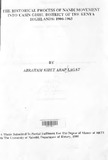| dc.description.abstract | This study reconstructs the history of Nandi squatter labourers in Uasin Gishu district of
Kenya between 1906 and 1963. It portrays the conflict and contradictions of a colonial situation. The
major players were the squatters, the colonial state and the European settlers.
By impinging on Nandi socio-economic institutions, the colonial administration subjected the
Nandi to specific demands. These included the alienation of their land, creation of a reserve and
taxation. The colonial presence was also an important element in the consolidation of the once
divergent Bororiosiek into a homogeneous Nandi society.
The thesis shows that the Nandi; though severely constrained, were not disheartened by
colonial land alienation. Deprived of their vital grazing land and salt licks, they resourcefully
exploited other survival opportunities in squatterdom.
It is finally suggested that aspects of underdevelopment of the Nandi squatters by the settlers,
supported by the colonial government, was common in the whole process of squatterdom. The
various Legislations ordering for the elimination of squatter stock was a means of underdeveloping
the Nandi squatters whose cattle were a symbol of wealth and development. The white settlers
represented the capitalist development which underdeveloped the squatters by eliminating their stock
and limiting the land for cultivation. This study thus hinges on the framework of underdevelopment
theory. | en |

